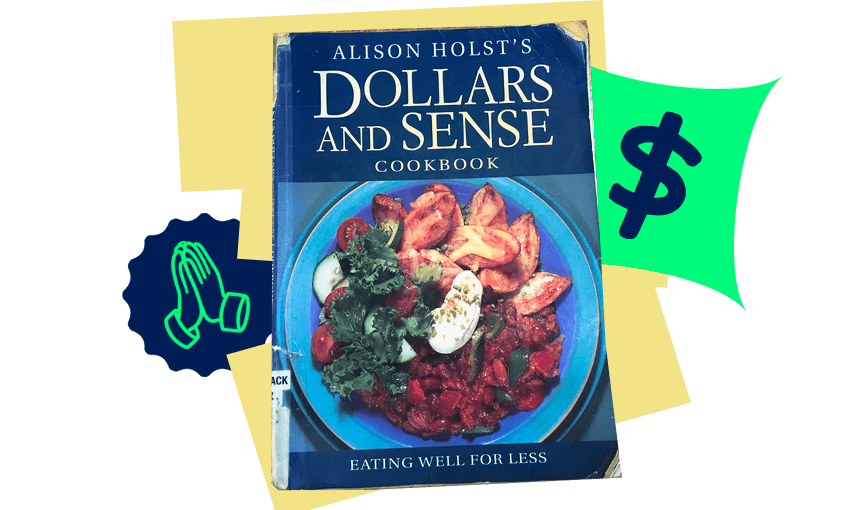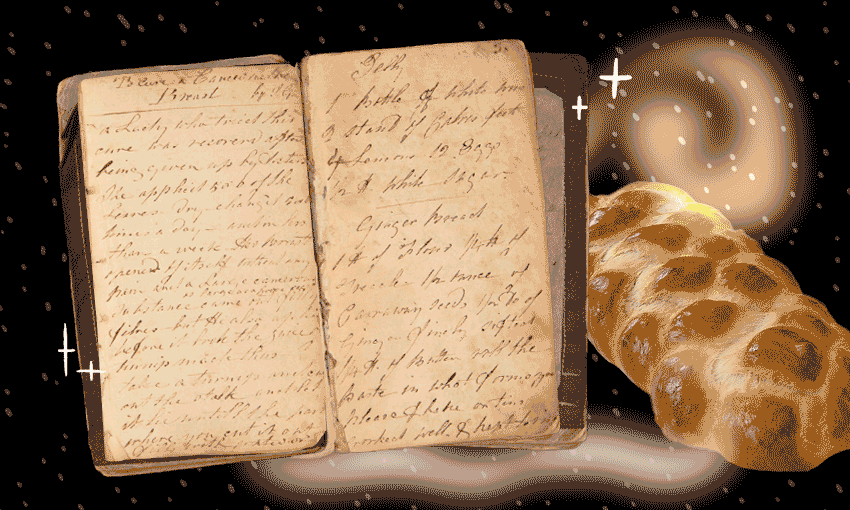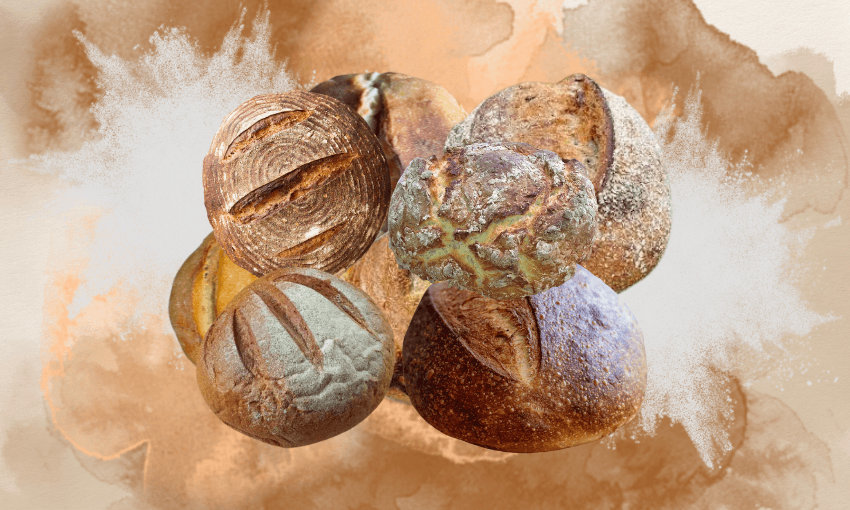Alison Holst’s 1995 cookbook Dollars and Sense compiled a collection of meals for New Zealanders on a budget. Charlotte Muru-Lanning takes a look at how affordable those recipes are when you apply today’s food prices.
Within the ongoing cost of living crisis, the ballooning price of food has dominated headlines the world over. Across the board, grocery food in February in New Zealand was 12% more expensive than the year before. The price of meat and fish jumped 9.8% in the same period, and fruit and vegetables made an astonishing 23% leap. And this was before the flooding in February that devastated some of the most fertile agricultural areas in the country.
Against this bleak and bank-breaking backdrop I found a beacon of hope at the local library in the form of Dollars and Sense: Eating Well for Less, the 1995 edition of a cookbook by one of the godmothers of New Zealand cooking, Alison Holst.
“It can be discouraging and demoralising to walk around a supermarket, looking at food prices, knowing that you do not have enough money to buy the things you would like,” Holst writes in the introduction. “I hope that this book will help and encourage you, if you want to spend only a small amount of money on food.”
The book, published in 1985, 1995 and then 1999, is filled to the brim with recipes that combine the warmth with practicality that Holst is so known for. Among the collection of recipes geared toward budget-minded families are plentiful casseroles, soups and slow cooks. And of course plenty of versions of Holst’s famous pancakes.
What I really wanted to know was, almost three decades later, would these economical recipes still pass as affordable?
For this, I selected 15 recipes at random from the dinner recipes in Dollars and Sense. Then, I chose the seven meals from the bunch that served at least four and that had the most similar ingredients, so as to condense my shopping list as much as possible. I made an online grocery list from all the ingredients at my closest supermarket. I chose the cheapest version of each item – except for eggs (free range by the dozen), Worcestershire sauce (Lea and Perrins over the cheaper brands) and tasty cheese (a block rather than the slightly cheaper grated version). I roughly calculated the percentage of the ingredient used in each recipe to determine the cost to cook each dish.
Here’s a breakdown of seven nights of dinners for four.
Monday: Mediterranean bean soup
This soup called for one and a half cups of dried haricot or baby lima beans, two to three garlic cloves, bay leaves, two large onions, two carrots, two to three stalks of celery, a 400g can of whole tomatoes, a quarter cup of chopped parsley, and salt and pepper.
The most expensive elements of this were the celery stalks, which I’d estimate at about $2 worth, from a whole celery that cost an eye-watering $6.99. I swapped the listed dried beans (not available at the supermarket) for a can of cannellini beans that cost $1.60 – but it would likely be more economical to use the dried version. Still, this dish worked out to be the cheapest of all the dinners of the week.
On its own, this would likely be enough to serve a whānau of four as it’s described as “about eight servings”, however, as it’s a relatively bare-bones soup, Holst does suggest that one serve this soup with “crusty, solid bread”. As such, a slice or two of buttered toast for each person wouldn’t go amiss here. A bag of Vogel’s (my preference) was $5 or you could grab a bag of the cheapest white loaf for $3.
Estimated ingredient cost: $9.54
Tuesday: Tuna and tomato casserole
The ingredient list for this involves 100g of pasta, an onion, two stalks of celery, a can of Mexican tomatoes, a 185g can of tuna, one tablespoon of lemon juice, parsley, a few tablespoons of cream cheese, a cup of tasty cheese and paprika.
This dish is practically begging for a side of roast vegetables, some just-boiled peas or a big bowl of salad with a sharp dressing – meaning an additional cost of around $3.30-$5.50.
Estimated ingredient cost: $16.28
Wednesday: Kūmara corn cakes with ‘brocauli’ salad
For the kūmara corn cakes, you need 500g of kūmara, oil, one onion, two garlic cloves, one cup of cooked corn, ground cumin, a few tablespoons of chopped coriander, two eggs and some self-raising flour. The salad is made up of a mix of 250g of broccoli, 250g of cauliflower, olive oil, white wine vinegar, a garlic clove and oregano.
As we’ve found out the hard way this year, kūmara are dramatically affected by the weather. Wild weather very much equates to wild prices – these were $10.99 per kilogram from my local supermarket, and meant that $5.50’s worth of kūmara were needed for this recipe. The single head of cauliflower for the salad was, and I can’t believe I’m saying this, $7.99.
Estimated ingredient cost: $11.93 for the kūmara corn cakes, and $8.80 for the “brocauli salad”
Thursday: Cabbage topped hot pot
To make this you’ll need oil, two onions, 400g of minced beef or mutton, curry powder, long grain rice, Worcestershire sauce, two carrots, two celery stalks, a packet of soup mix and 300g of shredded cabbage.
Despite its “peasant-cuisine” image, the half cabbage I added to my online shopping cart cost a whopping $5.99. And, let me be clear, these are not those gargantuan cabbages you might sometimes find at produce markets and fruit and vegetable stores, these are absolutely minuscule balls of leaf.
Estimated ingredient cost: $20.55
Friday: Old-fashioned fish pie
On the ingredient list were: 750g of potatoes, two leeks, butter, a can of smoked fish fillets, two eggs, milk, curry powder, flour and a couple of spoons of parmesan.
It’s rare that you find cheap leeks at the supermarket in Aotearoa, and yet I was still shocked by the staggeringly high price for the two leeks needed for this dish: $9.58 (43% of the total ingredient spend).
All up, the ingredients needed for this dish would cost around $22.15. However, a dish like this is in desperate need of a crisp green salad – at the very least – to cut through the creaminess. At my local supermarket, the best-value options to fill a salad bowl for a family of four, whether that be a bag of medley salad mix or a globe of iceberg lettuce, go for $5.50 each.
Estimated ingredient cost: $22.15
Saturday: Self-crusting corn quiche
You’ll need to gather together one onion, a tablespoon of butter, two potatoes, half a cup of milk, three eggs, a quarter cup of flour, a can of creamed corn, a cup of tasty cheese and one tomato to make this.
Despite being described as a dish for four, a glance over the ingredient measurements does make me suspect that this is a dinner on the lighter side. With that in mind, it’s likely this course would do well with a slaw or steamed vegetables.
Estimated ingredient cost: $10.48
Sunday: Lamb shanks with macaroni
The last things you’ll need to add to your shopping basket for these seven weekly dinners are eight lamb or hogget shanks (sadly no hogget shanks at my supermarket so I opted for a pack of three lamb shanks), three onions, four garlic cloves, a 190g jar of tomato paste, oregano, Worcestershire sauce, sugar, rosemary and a cup of macaroni.
Estimated ingredient cost: $26.18
So how affordable is this week of dinners?
At my local supermarket the total grocery price for all the necessary items on the list for a week of dinners for four came to $218.46. Presuming you already have all the spices, dried herbs, milk, flour, Worcestershire sauce and butter, the grocery basket could cost as low as $161.45.
To be clear, that’s a grocery basket filled with solely the ingredients needed for dinner and without any of the additional food needed for breakfast, lunchboxes or snacks, or cleaning products or toiletries, or kai a whānau might need for unexpected events like a school shared lunch or visitors.
It’s difficult to compare the affordability between 1995, when the book was published, with today, as there’s little specific data available. But, in November 1998, the average entire weekly food bill in Aotearoa reportedly came to $113.97. Today, according to the Reserve Bank’s inflation calculator, that would equate to $209.62. The shopping list just to buy the ingredients for these seven dinners is already $8.84 more than that.
In 2019, a University of Otago survey estimated weekly food costs for a family of four to meet basic nutritional needs at between $206 and $217 per week. In 2023, the same survey estimated that for a family of four to meet basic nutritional needs it would cost $273 per week.
In a report published in 2021, food security collective Kore Hiakai Zero Hunger Collective used these weekly food costs to consider the affordability of food within different income scenarios. Really, whether or not these meals from 1995 are affordable or not isn’t a yes or no answer – rather, the affordability of these meals depends on your income.
When it comes to a two adult, two child family living off Jobseeker income with a total net income of $905.30 after $501.25 housing costs and $307.84 fixed living costs, $96.21 would be left over for food. Enough for less than half the groceries needed to make these dinners. On the other hand, the same family formation living on the median wage would have around $690.97 left over after housing costs and fixed living costs. While around 64% of the Jobseeker family’s income is needed to pay for basic grocery expenses, 26% of the median wage family’s income is needed for the same.
While we might all share in our shock over the price of eggs or kūmara or cabbage needed for a so-called “budget” recipe, these numbers perhaps best express how the burden of the cost of living crisis is felt far more profoundly by those on lower incomes than those who earn more.






